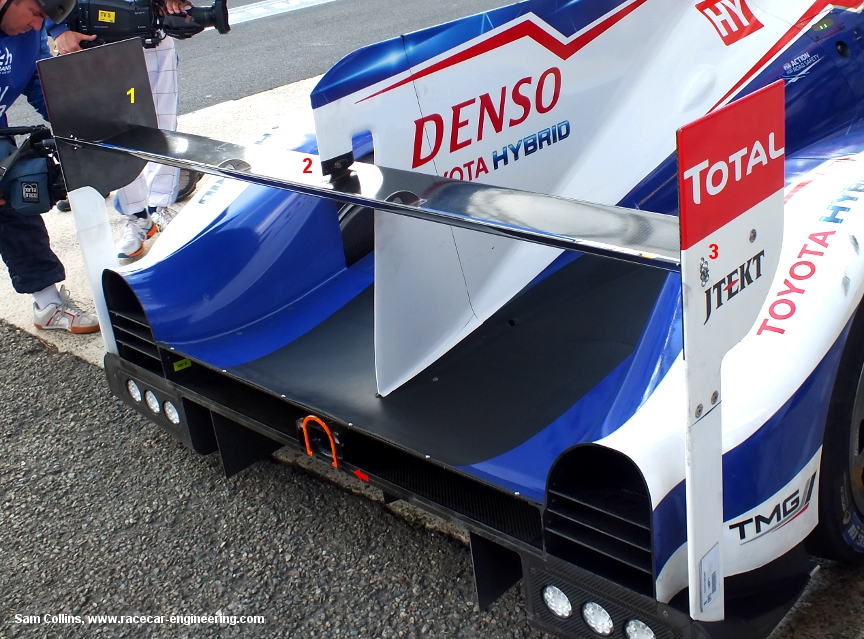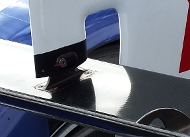Pete
Lyons' fantastic Can-Am Cars in Detail:
 |
July/August 2014
Reload
to see the latest news
All news content copyright Michael J. Fuller, unless
otherwise noted |
Mulsanne's Corner Book Store
A selection of sports car related DVDs and books, with a technical slant. | | >>Le Mans 2014<< | | 7.21.14
>>So
It's been a couple of weeks and things had seem to have gone quiet on
the Toyota Winggate. Well I have news, but first let's recap. Recall
that Toyota has introduced a rotating rear wing that is designed to
move under load (while the car is moving on the track) that has the
intentional benefit of reducing drag. Toyota have two versions of the
wing in service, and switched back and forth between the two during the
Le Mans weekend, and even during the race (race day photos
show the #8 running both at various times):
 | The
first version is identifed by the inboard bracket (1) that connects the
main plane to the endplate. The wing mount is silver and features
a round bolt (2). The final feature is the flap bolt hole pattern
(3) is a single row of approximately 8 holes.
This version of the wing aligns with the original description:
The
rear wing mainplane is attached to the central swan neck rear wing
mount through a single mounting point. The secondary flap
attaches to the mainplane via conventional slot gap separator brackets.
Outboard, the mainplane has a single attachment point at the
endplate and the secondary flap also has a single attachment point for
angle changes, as one would expect.
The
outboard ends of the assembly are actually attached to the endplate and
the wing's rotation is limited to the middle section. The
laminate schedule of the wing is designed to facilitate the rotation,
thus the wing actually deforms (though non-uniformly; thus it would
seem to mean the wing, once rotated into its low drag nose up
positions, is no longer a uniform section and in violation of Art 3.6.2
a.2). Ironically Toyota's competitors have dubbed this one as the "more legal" version. | 
© Chris Savage 2014 | This is how Version 1 works. | | |  | The second version lacks any brackets inboard of the endplate (1).  The
wing mount is black (2) and has a raised oval shape in the middle.
Outboard on the endplate, the flap holes (3) are two parallel rows of 3
and 4 bolts respectively. The
wing mount is black (2) and has a raised oval shape in the middle.
Outboard on the endplate, the flap holes (3) are two parallel rows of 3
and 4 bolts respectively.
This
version of the wing actually allows the entire
wing assembly to pivot. The pivot point being the secondary flap
bolt (3). The forward bolt appears to be false or to have
no function.
Evidence of this movement came in the form of scuff marks on the inside face of the endplate (1). | 
© Chris Savage 2014 | Version 2 in action. From a drag reduction standpoint I can
imagine this is the more effective device of the two. | | |
So
the latest news is that it has come to light that, following a meeting
of the Technical Working Group a few weeks ago, the FIA has taken
Toyota's concept into consideration and deemed that the wing mounting
(the wing mounting mind you) is, "...(is) not acceptable at future WEC
races." Therefore the expectation is that Toyota's rear wing drag reduction system will no longer be on the TS040 at the Austin WEC round. The statement is less definitive than one would have thought and certainly makes one wonder why it was deemed acceptable at past WEC events. So is that the end of it? My only suggestion is to keep an eye on Toyota's rear wing at future events. | 
|
|

